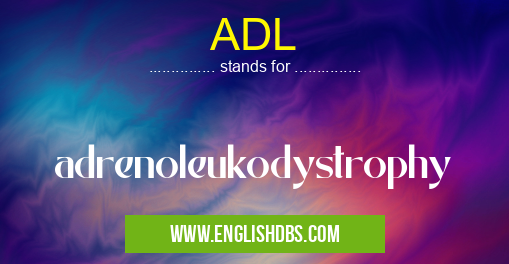What does ADL mean in BRITISH MEDICINE
Adrenoleukodystrophy (ADL) is an inherited metabolic disorder in which the fatty acid oxidation process is defective. This condition is caused by a mutation in the ABCD1 gene, which codes for a protein necessary for the normal processing of certain long-chain fats. People with ADL experience a wide range of symptoms, depending on their age and the severity of their condition. The primary symptom of this disorder is an abnormal breakdown and accumulation of very long chain fatty acids (VLCFAs), which can lead to neurological impairment, adrenal gland dysfunction, mental retardation, and death.

ADL meaning in British Medicine in Medical
ADL mostly used in an acronym British Medicine in Category Medical that means adrenoleukodystrophy
Shorthand: ADL,
Full Form: adrenoleukodystrophy
For more information of "adrenoleukodystrophy", see the section below.
Symptoms
The most common symptoms of ADL include seizures, spasticity, hearing loss, vision problems, developmental delays, psychiatric problems, and behavioral issues. Seizures may begin in infancy or later in childhood. They may be accompanied by changes in consciousness or impaired cognitive function. Hearing loss occurs due to progressive damage to the auditory nerve; vision problems typically manifest as early onset strabismus or cortical blindness associated with severe neurodegenerative disease. Cognitive impairment includes delayed development and/or learning disabilities; psychiatric symptoms can range from mild anxiety to severe psychosis; behavioral issues are similar to those seen with autism spectrum disorders.
Diagnosis & Treatment
Diagnosis of ADL requires a thorough evaluation including physical exam, blood tests for VLCFA levels and imaging studies such as brain MRI or CT scan to look for areas of demyelination or white matter atrophy – both signs suggesting ADL activity within the brain tissue. Once diagnosed, treatment focuses on managing symptoms and preserving quality of life through diet modification (avoiding high-fat foods), medications (to control seizure activity and stabilize mood), physical therapy (to address spasticity and coordination deficits) and occupational therapy (to address poor daily functioning). In cases where neurological deterioration has already occurred due to demyelination, stem cell transplants can help reverse some of these effects; however they have only been proven successful in certain cases.
Essential Questions and Answers on adrenoleukodystrophy in "MEDICAL»BRITMEDICAL"
What is adrenoleukodystrophy (ALD)?
Adrenoleukodystrophy (ALD) is a rare, inherited disorder that affects the nervous system and other organs. It is characterized by a buildup of fatty deposits called very long-chain fatty acids on organs such as the brain, adrenal glands, and spinal cord. This can lead to serious symptoms such as problems with movement, sensation, behavior, speech, vision, and hearing.
Who is most affected by ALD?
Adrenoleukodystrophy (ALD) predominantly affects males. However, female carriers may experience milder symptoms of ALD or none at all.
What are the common symptoms of ALD?
Common symptoms of ALD include poor coordination; difficulty walking; mental impairment; loss of speech; behavioral changes such as aggression or agitation; vision loss; and hearing loss.
Can ALD be treated?
Yes, although there is no cure for ALD, treatments are available which may help manage the symptoms associated with it. These include enzyme replacement therapy to reduce very long chain fatty acid levels in the blood and diet therapies to limit their synthesis in new cells.
What steps can I take if I think I have ALD?
If you think you may have adrenoleukodystrophy (ALD), it’s important to speak with your healthcare provider right away so they can provide an appropriate diagnostic assessment and determine the best course of treatment for you.
Is there a genetic test for ALD?
Yes, a genetic test can diagnose adrenoleukodystrophy (ALD). A blood sample will be taken and analyzed for mutations in particular genes associated with this disorder. Depending on the results from this test, further treatment options may be discussed with your doctor.
How can I prevent my child from getting ALD?
Prevention of adrenoleukodystrophy (ALD) involves genetic counseling before pregnancy on options available to reduce or eliminate risks associated with passing on copies of defective genes that cause this condition to future generations. Genetic testing prior to pregnancy can also indicate whether one partner has already inherited an abnormal gene related to ALD.
Are there any clinical trials going on for treatments for ALD?
Yes, at present there are several clinical trials being conducted investigating new treatments for adrenoleukodystrophy (ALD). Further information about these studies can be found online or by speaking directly to your doctor.
Is there any support available for people living with ALD?
Yes – there are many organizations dedicated to helping patients affected by adrenoleukodystrophy (ALD) connect with resources for additional education and support services. Organizations such as The Leukodystrophy Foundation offer patient education materials as well as providing emotional support through patient forums and visits from trained professionals.
Are there any specific dietary recommendations related to managing my condition if I have been diagnosed with ALD?
Persons diagnosed with adrenoleukodystrophy (ALD) should consult their doctor regarding potential dietary considerations. Diet modifications may include limiting intake of certain fatty foods known to increase concentrations of very long chain fatty acids in cells that can worsen neurological conditions associated with this disorder.
Final Words:
Adrenoleukodystrophy (ADL) is a rare but serious genetic disorder that can affect individuals at any age. It causes an abnormal metabolism resulting in accumulation of VLCFAs which causes various neurological impairments like seizures, spasticity etc., leading to progressive decline unless treated timely with proper care plan consisting of diet modification, medications, physical & occupational therapy. Stem cell transplantation can potentially help halt progression if done promptly but it’s beneficial effects are still being studied.
ADL also stands for: |
|
| All stands for ADL |
